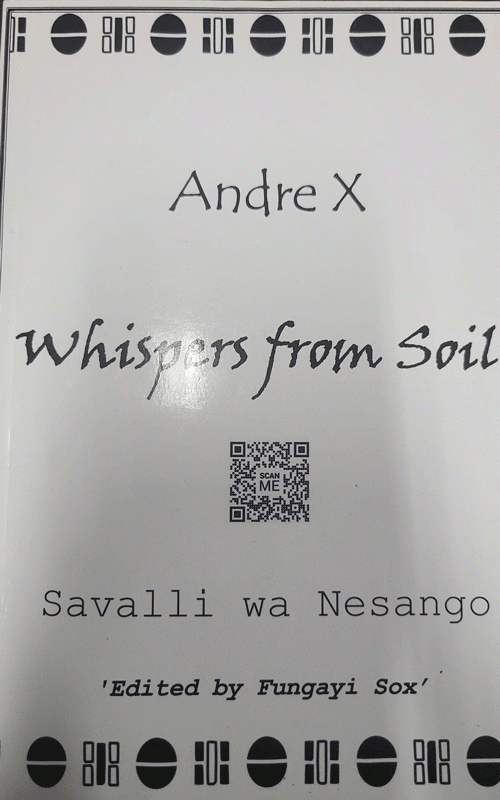
Beneath the watchful gaze of Great Zimbabwe’s stone sentinels, where the wind carries the breath of kings and the murmurs of forgotten battles, Whispers from Soil emerges — not as ink on paper, but as a living, breathing Bira.
In this text, Andre X ,Tendai Kwenda,a young prolific legal mind whom I profiled when he published his debut trilogy Whispers from Soil: The Rise of Gwenyambira back in 2022, shares a piece of work that is sacred, summoning voices across time. As an editor tracing the script’s contours, I did not just analyse the text — I was initiated into a ritual where every word vibrates with ancestral presence.
An overview
At its core, the love story of Savalli and Nesango transcends romance — it is an allegory for Africa’s wounded yet unbreakable spirit.
Thus, in the first act, Savali wa Nesango is a love story etched into the stones of Munhu Mutapa. Savallli, the seer with Asante blood and Nesango, the warrior prince, are more than characters, they are symbols.
Savalli embodies the resilience of African spirituality, resisting the erasure of colonialism, while Nesango represents the aristocratic class seduced by foreign ideals.
Their love is a love metaphor for the painful yet necessary union of tradition and modernity.
The Mbira, central to the narrative, is not merely an instrument but a voice.
- Understanding colonialism in Zimbabwe
- Travelling & touring: Matobo Hills conquers world tourism
- Independence: Why has Zim regressed?
- Another Great Zimbabwe monument in Marondera
Keep Reading
When Nesango plays it, the music, becomes a bridge between the worlds, much like how the book itself bridges poetry, drama and cultural manifesto.
AndreX’s language is lush and lyrical, weaving Shona proverbs with Shakespearean sonnets (as in Sonnet of Hopeful Whispers), thereby creating a hybrid form that feels both ancient and urgent.
“In the process of the storm have I seen, I, A King! Of no crown hath endured bleakness — A wild boar’s strength-anointed in finest oils I have been from sullen earth, hymns sung at heaven’s gate, —OH, sweet melody of lyre and the ten stringed harps fate.”
What captured my attention more was the essay, Ma’Moyo which confronts the marginalisation of African women with unflinching clarity, tying their struggle to the broader fight for democracy. “It appears that in the quest for freedom, women were called upon for support, their labour was required without considering how the double days keeps many of them from participating fully in public debates”—(pp.27-28)
This observation is not just theory — it is a mirror held up to Zimbabwe, where women like Tsitsi Dangarembga have been a symbol of defence against systemic oppression.
Opportunities
No book or literary piece is without its own weaknesses or gaps. The transition between Act 1’s lyrical drama and Act 2, musical spectacle (Bira re Vana Vedu) feels abrupt. The richness of Savalli and Nesango’s story begs for deeper exploration — perhaps a prequel delving into Savalli’s lineage or Nesango’s internal conflict as a ruler torn between the two worlds.
The prose though beautiful occasionally drowns in its own lyricism. Passages like “consciousness” risk alienating readers with dense metaphysical musings. Couldn’t the ‘Advocates’ wisdom be distilled into sharper, more accessible metaphors?”.
Context: Zimbabwe and African trilogy
Whispers from Soil: Savalli wa Nesango is a mere first part series of a larger scope of literary work — a trilogy that includes The Rise of Gwenyambira and an unnamed third work. Compared to its ‘siblings’, this volume stands out as the most musical. Where Gwenyambira focuses on the custodians of culture (like Duwai, the mbira maker), Whispers is the heartbeat, the emotional care.
In the “WhatsApp group” of African literature, the literary piece echoes Yvonne Vera’s Stone Virgins in its poetic historiography but diverges by embracing performative orality. It is a descendant of Dambudzo Marechera’s rebellion spirit, but rejects his nihilism, offering instead a vision of hope rooted in cultural revival.
A beacon for the continent
Whispers from Soil is not perfect — but neither is the struggle it depicts. Its strength lies in its audacity: to reimagine Great Zimbabwe not as a relic, but as a living creature, breathing resistance. It whispers to Zimbabwe’s youth, to the women marching for justice, to the artists strumming mbiras in Harare’s alleyways.
As the chorus of Nyarara fades, one hears the refrains of the trilogy, Aluta continua. The struggle continues — but so does the song.
More than a book
Andre X’s Whispers from Soil is more than a book—it is a crossroad where culture met a sacred fire around which diverse voices gather. Whispers from Soil stands as testament to the beauty forged when cultures collide, when past and present dance, when art becomes language, we all understand.
This is storytelling as survival. As celebration. As revolution.
nFungayi Antony Sox is literary champion, communications and publishing specialist with close to a decade of experience working with authors, creatives, brands and organisations across sectors. For feedback email him on [email protected] or contact him on +263 776 030 949.











